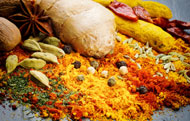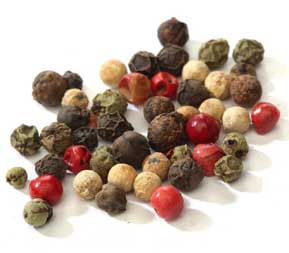




Spices -
is a good source of folate, dietary fiber, and vitamins C and K

1. Spice Facts
2. Tips for Cooking and Storage
3. Types of Spice
4. Spice Nutritional Value
5. Spice Health Benefits
2. Tips for Cooking and Storage
3. Types of Spice
4. Spice Nutritional Value
5. Spice Health Benefits
Spices Facts
A spice is a seed, fruit, root, bark, berry, bud or other vegetable substance primarily used for flavoring, coloring or preserving food.
History and Origin
Tips for Cooking and Storage
Tips for Cooking and Storage of Spices
(coming soon)
Common Types of Spice (Australia)
Types of Spice
- Allspice
- Bay leaves
- Black pepper
- Cardamom
- Cayenne pepper
- Cinnamon, ground and stick
- Chili powder
- Cloves
- Curry powder
- Ginger
- Mace
- Mustard seed, ground
- Nutmeg, ground
- Oregano
- Paprika
- Salt
- Saffron
- Turmeric
- Vanilla extract
- White pepper
Spices Nutritional Value
|
Spices ” Tumeric ” ( Nutritional value )
Nutritional value per 3 g – 1 Teaspoon Spices, turmeric, ground |
|||||||||||||||||||||||||||||||||||||||||||||||||||||||||||||||||||||||||||||||||||||||||||||||||||||||||||||||||||||||||||||||||||||||||||||||||||||
|
|||||||||||||||||||||||||||||||||||||||||||||||||||||||||||||||||||||||||||||||||||||||||||||||||||||||||||||||||||||||||||||||||||||||||||||||||||||

|
Reference Values are based on a 2,000 Calorie Intake, for Adults and Children 4 or More Years of Age. Your daily values may be higher or lower depending on your calorie needs.
|
|
Percentages are roughly approximated using (RDA) Recommended Dietary Allowances for adults. Source: USDA United States Department of Agriculture
|
|
Reference Values for Nutrition – National Institutes of Health USA
|
Spices Nutritional Value
Spices Health Benefits
Spices

HEALTH
References
|
Nutrient Database – USDA (United States Department of Agriculture)
|
|
Reference Values for Nutrition – National Institutes of Health USA
|
